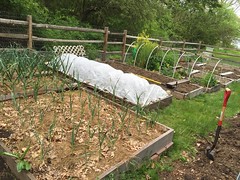


Finally! I've gotten the compost down to the garden (actually my husband did that for me - thank you, Steve!), spread and turn it. Then we hooked up the hose to get some water down to the garden. The brassica bed was ready for planting, so yesterday the plants went in! I have so many seedlings waiting to be planted that I'm so happy to be getting some planted. After planting and watering, I covered the bed with row cover to protect the plants from cabbage worms.
I planted three types of cabbage, napa, savoy and red. Also broccoli: mini and a package that had a mix of broccoli types. And a couple rows of bok choy Pechay.
3 comments:
I've found that leaving over-wintered leeks in the garden will make them flower in the spring. And that the flowers attract a steady quantity of a wild looking variety of wasp/bee type things - literally all day non-stop while the blooms are open [they last well more then a month]. And during that time, I have no cabbage worms [!], and the cabbage worms reappear right when the blooms truly die down.
At that point, I leave the plants in the ground, and in the fall collect the little "bulbletts" around the base of the leek plant under the soil, and replant them for another bed of leek flowers for the following spring. The bulbletts grow extremely rapidly - unlike seeds, and will be good sized by the spring despite basically going dormant over the winter. I have been controlling the worms this way for several years, and discovered it by accident. The slugs seem fewer, but I am unsure if that is related. The worms reappear so quickly after the flowers are gone though, so that seems to be a clearer connection.
I've never seen leek flowers. Wow. Sounds great. I have an over abundance of leek seedlings this spring and was thinking I'll plant a few here and there. I usually plant all my onions at my community plot. But I've heard about the companion benefits of onions and now leeks.
I am really looking forward to seeing how leeks propagate as you describe. I've never heard of this. Very exciting. I think I'll put in 3 or 4 small rows in a couple beds. I put some in my brassica bed. I love to grow plants with small flowers that attract the small bees and wasps. I usually grow dill. I'm glad to learn of more attractants of beneficial insects.
Thanks very much!
The leek flowers are quite stunning in the garden, and btw will need to be supported by stakes. I have only had overwintered ones [planted in previous spring from seedlings or in the previous fall from the "bulbils" around an old plant's base which when planted on their own grow really quick into large plants] flower like clockwork in the spring.
I too had never heard of all this! Apparently, in Britain where "veg" growing seems to take a particular sporting angle, ie "leek shows", people purposely propagate their special leeks this way because using the bulbils actually makes for a clone plant rather then risk the possible random traits that seed gown plants may have. And there is yet another way to make clones - which I have not tried: as I understand, once the leek flower is fully opened for a while - if you trim the flowery part down around the flower head - like a crew cut on the flower - and then allow what is called "leek grass" to grow around the trimmed flower head. If that is successful, each piece of "grass" is also a mini leek clone that can be planted.
I don't know about the "leek grass" method but I can attest that just leaving the spent flower plants in the ground, and pulling them up in the fall to collect the bulbils is very easy! And once you get the cycle going, it just perpetuates itself.
Post a Comment